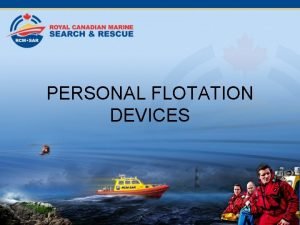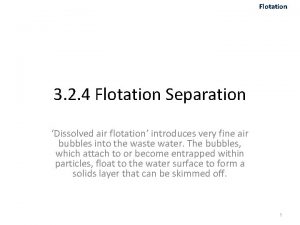Cold Water and Personal Flotation Kevin Monahan Shipwrite















- Slides: 15

Cold Water and Personal Flotation Kevin Monahan Shipwrite Productions www. shipwrite. bc. ca

How often have you read something like this? “I don’t understand how it happened. He was a good swimmer, he must have been hit on the head. ”

• UK Home Office 1977 • 55% of open water drowning deaths occurred within 3 meters of safety. • 42% occurred within 2 meters of safety. • 2/3 were regarded as good swimmers • Canada (Smart. Risk Research) • 41% of those who were boating and drowned were within 10 meters of shore. • An additional 22% were within 10 to 15 meters of shore From Transport Canada’s Safe Boating Guide 1 From Lewis Carrol’s Alice in Wonderland

• Clearly, something is preventing drowning people from saving themselves. • Many victims are unable to swim even 2 meters to save themselves. • Scientific evidence shows sudden immersion in cold water can result in death due to drowning long before hypothermia sets in • 40% to 60% of people who die as a result of being suddenly immersed in cold water die in the first 5 to 15 minutes. • (In Alaska, this figure is estimated to be as high as 75%) Sherlocke Holmes “When you have eliminated the impossible, my dear Watson, whatever remains, however improbable, must be the truth. ”

Effects of Sudden Cold Water Immersion • Stage 1: Initial immersion or cold shock Surface effects (skin, nervous system) • Stage 2: Short-term immersion or swimming failure Intermediate depth (muscles of arms and legs) • Stage 3: . Long-term immersion (hypothermia) Cooling of body core • Stage 4: Post-rescue collapse (heart &/or brain failure) Courtesy United States Coast Guard

Stage 1: Initial Immersion or Cold Shock • Drowning occurs rapidly (within 3 to 5 minutes) ØCold receptors in the skin cause immediate physiological responses. Peak response within 30 seconds ØLarge inspiratory gasp upon immersion – may cause drowning ØUncontrollable hyperventilation and reduced breath hold ability ØMay be unable to get air into lungs--leads to panic ØMassive increase in heart rate and blood pressure may trigger cardiac arrest ØUnable to self-rescue ØUnable to keep airway clear of water without help • Effects last for just a few minutes, but at the critical stage of ship abandonment or falling overboard.

Stage 2: Short-term immersion or swimming failure • Death by drowning occurs within 5 – 30 minutes ØRapid cooling of the musculature of the arms and legs ØAlmost complete loss of co-ordination, manual dexterity and muscle strength ØInability to self-rescue using flares or other survival equipment ØDegradation of swimming ability -- even short swims may be impossible – many who drown are reported to have been “good swimmers” ØInability to co-ordinate swimming stroke and breathing ØUnable to self-rescue ØUnable to keep airway clear of water without help

Airway Protection This is an airway protection device And so are these

What is “Cold Water”? • Any water less than 15 o C (59 o F) will trigger these physical reactions, though the colder the water, the more severe the response. • Some studies suggest that these reactions can occur in water as warm as 20 o C (68 o F) • If the water is warm enough that you aren’t concerned with cold water responses, you should keep a sharp eye out for Not really a shark. Actually a photo of a dolphin.

Lessons • On sudden immersion in cold water ØLong before you run the risk of death by hypothermia you can easily die from drowning if you don’t have a flotation aid to keep your airway above water. ØEvidence shows that you will very likely not be able to don a flotation aid once you have entered cold water-you must be wearing a PFD for it to save your life. ØYour goal must be to survive the first two stages of Cold Water Immersion--long enough to actually run the risk of hypothermia (20 to 30 minutes)--almost impossible without a flotation aid.

Current Attitudes • Pre-occupation with hypothermia as a cause of death may have had a detrimental effect on public perception. • Most boaters still believe they can don a PFD after they enter the water. • Many boaters believe the only reason to wear a PFD is in case of unconsciousness. This message is reinforced by government and non-government communications. • Currently most boaters have heard the message that they should wear their PFDs, but they do not understand WHY they should wear them. Still photo from James Cameron’s Titanic Leonardo di. Caprio and Kate Winslett would not have survived their experience below decks on the sinking Titanic.

What does this mean? • Drivers understand HOW seat belts save lives. • Cyclists understand HOW helmets prevent brain damage. • Cold water kills by cold shock or by swimming failure far more often than by hypothermia. • This occurs most often when people fall overboard or when small boats capsize. • If your small boat capsizes and you are ejected into the water, physiological reactions may prevent you from keeping your airway above water and you can easily drown.

• Henry Freeman was the only survivor of the Whitby lifeboat disaster of 1861 --because he was the only crewman wearing the new patent lifejacket. • His lifejacket was a simple low-tech device--but it saved his life. • You don’t have to be a rocket scientist to figure it out…. • Wear your PFD and live. Original photo of Henry Freeman by Frank M Sutcliffe, Copyright the Sutcliffe Gallery, Whitby, UK

Resources • The Essentials of Sea Survival Øby Frank Golden and Michael Tipton • Survival in Cold Waters Øby Dr Chris Brooks for Transport Canada (TP 13822) • "The Cold Facts – Surviving Sudden Cold Water Immersion". Ø Intercom Films, Toronto, (416) 483 -3862 • “Cold Water Boot Camp” Øwww. coldwaterbootcamp. com/pages/home. html

The End www. shipwrite. bc. ca
 Water and water and water water
Water and water and water water Shipwrite
Shipwrite Rosemary monahan
Rosemary monahan Don monahan
Don monahan Warm water rises in a lake. cold water descends.
Warm water rises in a lake. cold water descends. Saginata
Saginata Examples of floating and settling
Examples of floating and settling Welcome 1 unit 10 lesson 1
Welcome 1 unit 10 lesson 1 Zinc sulphate technique in parasitology
Zinc sulphate technique in parasitology Glass analysis forensics
Glass analysis forensics Boat flotation foam requirements
Boat flotation foam requirements Kinetics flotation chemicals
Kinetics flotation chemicals Flotation cost in cost of equity
Flotation cost in cost of equity Cost of equity
Cost of equity Bar games for adults
Bar games for adults Zinc sulphate centrifugal flotation technique
Zinc sulphate centrifugal flotation technique



























